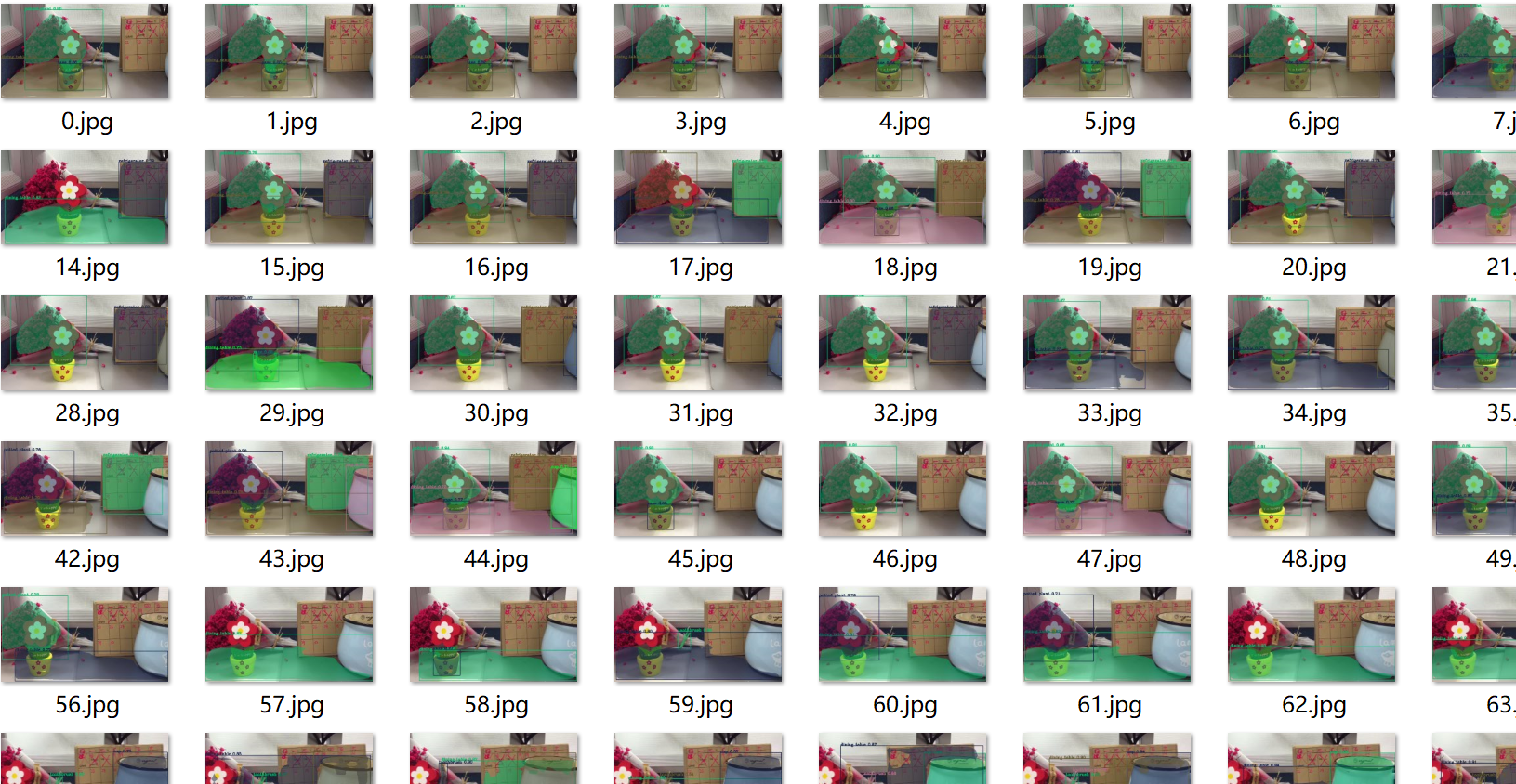代码参考:https://github.com/Tony607/colab-mask-rcnn
具体安装请见上一篇博客
分两步走:
①把下载好的视频变成一帧一帧的,对每一帧进行detection,把框,label,scores都标在图上,保存成图片
② 把保存好的一帧一帧的图片,合成视频
有些同学可能不太懂怎么获取摄像头
下面的代码是一个小demo——如何获取摄像头或者获取本地视频,并显示在当前窗口上
import cv2
import numpy as np#添加模块和矩阵模块
cap=cv2.VideoCapture(0)
#打开摄像头,若打开本地视频,同opencv一样,只需将0换成("×××.avi")
while(1): # get a frame
ret, frame = cap.read() # show a frame
cv2.imshow("capture", frame)
if cv2.waitKey(1) & 0xFF == ord('q'):
break
cap.release()
cv2.destroyAllWindows()第一步:
把下载好的视频变成一帧一帧的,用Mask RCNN检测物体
import cv2
import numpy as np
# 定义随机颜色函数
def random_colors(N):
np.random.seed(1)
colors=[tuple(255 * np.random.rand(3)) for _ in range(N)]
return colors
def apply_mask(image,mask,color,alpha=0.5):
for n, c in enumerate(color):
image[:, :, n] = np.where(
mask == 1,
image[:, :, n] * (1 - alpha) + alpha * c,
image[:, :, n]
)
return image
def display_instances(image, boxes, masks, ids, names, scores):
"""
take the image and results and apply the mask, box, and Label
"""
n_instances = boxes.shape[0]
colors = random_colors(n_instances)
if not n_instances:
print('NO INSTANCES TO DISPLAY')
else:
assert boxes.shape[0] == masks.shape[-1] == ids.shape[0]
for i, color in enumerate(colors):
if not np.any(boxes[i]):
continue
y1, x1, y2, x2 = boxes[i]
label = names[ids[i]]
score = scores[i] if scores is not None else None
caption = '{} {:.2f}'.format(label, score) if score else label
mask = masks[:, :, i]
image = apply_mask(image, mask, color)
image = cv2.rectangle(image, (x1, y1), (x2, y2), color, 2)
image = cv2.putText(
image, caption, (x1, y1), cv2.FONT_HERSHEY_COMPLEX, 0.7, color, 2
)
return image
if __name__ == '__main__':
"""
test everything
"""
import os
import sys
from mrcnn import utils
import mrcnn.model as modellib
from mrcnn import visualize
import coco
# We use a K80 GPU with 24GB memory, which can fit 3 images.
batch_size = 3
#ROOT_DIR = os.getcwd()
ROOT_DIR =os.path.abspath("../") # 根目录的地址
MODEL_DIR = os.path.join(ROOT_DIR, "logs")
VIDEO_DIR = os.path.join(ROOT_DIR, "videos") #原始视频存放的文件夹
VIDEO_SAVE_DIR = os.path.join(VIDEO_DIR, "save2") #每一帧图片所存放的文件夹
COCO_MODEL_PATH = os.path.join(ROOT_DIR, "mask_rcnn_coco.h5")
if not os.path.exists(COCO_MODEL_PATH):
utils.download_trained_weights(COCO_MODEL_PATH)
class InferenceConfig(coco.CocoConfig):
GPU_COUNT = 1
IMAGES_PER_GPU = batch_size
config = InferenceConfig()
config.display()
model = modellib.MaskRCNN(
mode="inference", model_dir=MODEL_DIR, config=config
)
model.load_weights(COCO_MODEL_PATH, by_name=True)
class_names = [
'BG', 'person', 'bicycle', 'car', 'motorcycle', 'airplane',
'bus', 'train', 'truck', 'boat', 'traffic light',
'fire hydrant', 'stop sign', 'parking meter', 'bench', 'bird',
'cat', 'dog', 'horse', 'sheep', 'cow', 'elephant', 'bear',
'zebra', 'giraffe', 'backpack', 'umbrella', 'handbag', 'tie',
'suitcase', 'frisbee', 'skis', 'snowboard', 'sports ball',
'kite', 'baseball bat', 'baseball glove', 'skateboard',
'surfboard', 'tennis racket', 'bottle', 'wine glass', 'cup',
'fork', 'knife', 'spoon', 'bowl', 'banana', 'apple',
'sandwich', 'orange', 'broccoli', 'carrot', 'hot dog', 'pizza',
'donut', 'cake', 'chair', 'couch', 'potted plant', 'bed',
'dining table', 'toilet', 'tv', 'laptop', 'mouse', 'remote',
'keyboard', 'cell phone', 'microwave', 'oven', 'toaster',
'sink', 'refrigerator', 'book', 'clock', 'vase', 'scissors',
'teddy bear', 'hair drier', 'toothbrush'
]
capture = cv2.VideoCapture(os.path.join(VIDEO_DIR, 'mydesk.mp4')) #这里是输入视频的文件名
try:
if not os.path.exists(VIDEO_SAVE_DIR):
os.makedirs(VIDEO_SAVE_DIR)
except OSError:
print ('Error: Creating directory of data')
frames = []
frame_count = 0
# these 2 lines can be removed if you dont have a 1080p camera.
capture.set(cv2.CAP_PROP_FRAME_WIDTH, 1920)
capture.set(cv2.CAP_PROP_FRAME_HEIGHT, 1080)
while True:
ret, frame = capture.read()
# Bail out when the video file ends
if not ret:
break
# Save each frame of the video to a list
frame_count += 1
frames.append(frame)
print('frame_count :{0}'.format(frame_count))
if len(frames) == batch_size:
results = model.detect(frames, verbose=0)
print('Predicted')
for i, item in enumerate(zip(frames, results)):
frame = item[0]
r = item[1]
frame = display_instances(
frame, r['rois'], r['masks'], r['class_ids'], class_names, r['scores']
)
name = '{0}.jpg'.format(frame_count + i - batch_size)
name = os.path.join(VIDEO_SAVE_DIR, name)
cv2.imwrite(name, frame)
print('writing to file:{0}'.format(name))
# Clear the frames array to start the next batch
frames = []
capture.release()
会在save2中生成每一帧图片对应的检测结果:

第二步:将文件夹中的每一帧图片合为一个视频
def make_video(outvid, images=None, fps=30, size=None,
is_color=True, format="FMP4"):
"""
Create a video from a list of images.
@param outvid output video
@param images list of images to use in the video
@param fps frame per second
@param size size of each frame
@param is_color color
@param format see http://www.fourcc.org/codecs.php
@return see http://opencv-python-tutroals.readthedocs.org/en/latest/py_tutorials/py_gui/py_video_display/py_video_display.html
The function relies on http://opencv-python-tutroals.readthedocs.org/en/latest/.
By default, the video will have the size of the first image.
It will resize every image to this size before adding them to the video.
"""
from cv2 import VideoWriter, VideoWriter_fourcc, imread, resize
fourcc = VideoWriter_fourcc(*format)
vid = None
for image in images:
if not os.path.exists(image):
raise FileNotFoundError(image)
img = imread(image)
if vid is None:
if size is None:
size = img.shape[1], img.shape[0]
vid = VideoWriter(outvid, fourcc, float(fps), size, is_color)
if size[0] != img.shape[1] and size[1] != img.shape[0]:
img = resize(img, size)
vid.write(img)
#vid.release()
return vid
import glob
import os
# Directory of images to run detection on
ROOT_DIR =os.path.abspath("../")
VIDEO_DIR = os.path.join(ROOT_DIR, "videos")
VIDEO_SAVE_DIR = os.path.join(VIDEO_DIR, "save2")
images = list(glob.iglob(os.path.join(VIDEO_SAVE_DIR, '*.*')))
# Sort the images by integer index
images = sorted(images, key=lambda x: float(os.path.split(x)[1][:-3]))
outvid = os.path.join(VIDEO_DIR, "mydesk_out.mp4")
make_video(outvid, images, fps=30)
print('make video success')
生成一个mydesk_out.mp4的文件夹
